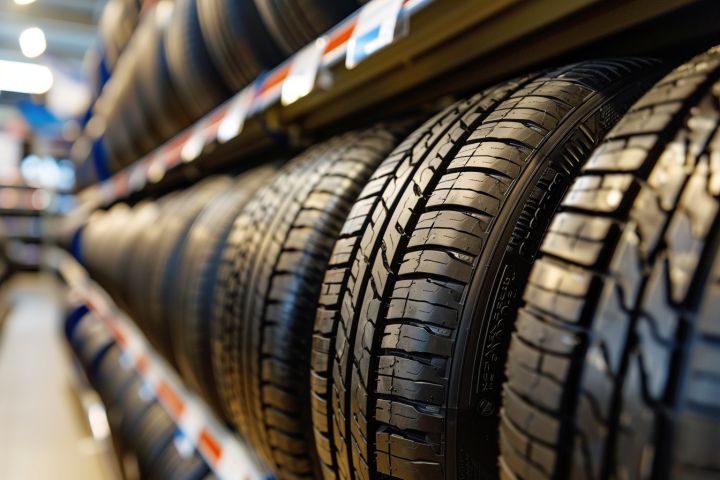Last Updated on 2 weeks
Introduction to the World of Tire Sizes
Tire sizes are a crucial yet often overlooked element in automotive design and engineering. This aspect of vehicle construction is not merely a matter of aesthetics or an arbitrary feature; it is deeply rooted in vehicular performance’s functional and safety aspects. The array of tire sizes available in the market is not a product of chance but a response to the diverse requirements of different vehicles and driving conditions. From compact city cars to robust all-terrain vehicles, each has unique tire size requirements that influence their performance, safety, and efficiency.
Understanding the world of tire sizes opens a window into the intricate balance between vehicle design, environmental considerations, and the evolving demands of road safety and driving experiences. This introduction aims to unravel the complexities and curiosities behind the varied tire sizes, offering insight into why this diversity exists and how it shapes our driving world.

The Curiosity Behind Various Tire Sizes
While seemingly a simple aspect of a vehicle, tire sizing plays a critical role in modern automotive design. Beyond their fundamental function, tire dimensions are meticulously chosen to influence a vehicle’s performance, handling characteristics, and safety. This intricate relationship between tire size and vehicle function necessitates a deeper understanding of the various size designations and their associated implications.
1. The Origin of Diversity in Tire Sizes
The diversity in tire sizes originated from the need to accommodate different types of vehicles and their intended uses. Each vehicle, from small cars to large trucks, requires a tire size that complements its functionality. For instance, sports cars often use wider tires for better grip and handling, while larger vehicles like trucks require higher load-carrying capacities.
2. Impact of Vehicle Design
Vehicle design heavily influences tire size. A vehicle’s weight, power, and intended use determine the optimal tire size for safety and efficiency. More significantly, heavier vehicles need larger tires for stability and load management, while more minor, lighter vehicles can perform optimally with smaller tires.
3. Tire Size and Driving Conditions
Different driving conditions necessitate different tire sizes. For instance, off-road vehicles require more extensive, robust tires for traction on rough terrains, whereas city cars use smaller tires suited for smoother roads and better fuel efficiency.
4. Technological Advancements
Technological advancements in tire manufacturing have allowed for a broader range of tire sizes. Developing new materials and designs has enabled the production of tires specific to the needs of different vehicles and driving environments.
The History and Evolution of Tire Sizes
The journey of tire sizes from their inception to the present day is a fascinating tale of innovation, technology, and adaptation. This evolution has been crucial in shaping vehicles’ efficiency, safety, and performance.
The Early Days of Tire Manufacturing
Embark on a historical exploration of the early days of tire manufacturing, tracing the evolution of tires from their rudimentary beginnings. This introduction offers a glimpse into the pioneering days when the foundations of modern tire technology were laid, shaping the future of transportation.
1. The Invention of the Pneumatic Tire
The tire industry was revolutionized by the invention of the pneumatic tire in the late 19th century by John Boyd Dunlop. These early tires were simple, air-filled tubes wrapped in rubber and canvas, designed primarily to offer a smoother bicycle ride.
2. Tires in the Early Automotive Era
As automobiles emerged, tire design evolved to meet the new challenges. The early 20th century saw the transition from solid rubber tires to pneumatic tires for cars, driven by the need for better shock absorption and improved vehicle performance.
3. Standardization Challenges
The early automotive industry faced a challenge in tire standardization. Different tire sizes across manufacturers created compatibility issues, hindering progress.
How Technological Advancements Shaped Tire Sizes
Delve into the fascinating story of how technological innovations have influenced tire sizes. This introduction explores the dynamic relationship between evolving technology and the changing dimensions of tires, reflecting the continuous quest for improved performance and safety in automotive design.
1. Introduction of Synthetic Rubber
The development of synthetic rubber during World War II was a significant milestone. It provided a consistent and reliable material for tire manufacturing, leading to more uniform tire sizes and improved quality.
2. Radial Tire Innovation
Michelin’s invention of the radial tire in the 1940s was another turning point. Radial tires, with their layered steel belts, offered better durability, fuel efficiency, and road grip, influencing the design and size of modern tires.
3. The Impact of Vehicle Evolution
As vehicles evolved, so did tire sizes. The demand for higher performance, safety, and fuel efficiency led to the development of broader, lower-profile tires. Sports cars and luxury vehicles, in particular, pushed the boundaries of tire size and design for better handling and aesthetics.
4. Specialty Tires for Diverse Applications
The need for tires suited to specific conditions led to the creation of specialty tires. From off-road tires with deep treads to low-rolling-resistance tires for electric and hybrid cars, the diversity in tire sizes and types expanded significantly.
5. Advanced Manufacturing Technologies
Advancements in manufacturing technologies have enabled more precise and efficient production of various tire sizes. Computer-aided design and manufacturing processes have made a broader range of sizes and types available to consumers.
Understanding Tire Size Nomenclature
Demystifying tire size terminology empowers both car owners and enthusiasts. This knowledge equips them to make informed choices when selecting tires that optimize performance and ensure compatibility with their vehicles.
Deciphering Tire Size Labels
Tire size labels are more than just random numbers and letters; they provide information about the tire’s specifications.
1. Common Format of Tire Size Labels
Most tire size labels follow a standard format: P215/65R15 95H. Each segment of this label holds specific information about the tire.
2. Type of Vehicle
The first letter indicates the type of vehicle the tire is designed for. For example, “P” stands for passenger vehicle, “LT” for light truck, and “T” for temporary (spare tires).
3. Tire Width
The first three-digit number (215 in the example) represents the tire’s width from one sidewall to another in millimeters.
4. Aspect Ratio
The two-digit number after the slash (65 in the example) is the aspect ratio, which is the height of the tire’s cross-section to its width. A smaller number indicates a lower-profile tire.
5. Tire Construction
The letter following the aspect ratio (R in the example) denotes the tire’s construction, with “R” indicating a radial tire.
6. Rim Diameter
The number following the construction letter (15 in the example) indicates the diameter of the wheel rim in inches.
7. Load Index and Speed Rating
The final part (95H in the example) combines the load index and speed rating. The load index (95) denotes how much weight the tire can support, while the speed rating (H) indicates the maximum speed the tire is rated for under optimal conditions.
The Meaning Behind Numbers and Letters
Each number and letter on a tire size label provides crucial information about the tire’s size, type, and performance capabilities.
1. Service Description
Some tires include a service description after the size marking. This description combines the load index and speed rating, quickly referencing the tire’s capacity and speed capabilities.
2. Additional Markings
Tires may also have additional markings indicating special features or certifications, such as M+S (mud and snow) or the Three-Peak Mountain Snowflake symbol, indicating suitability for severe snow conditions.
3. Importance of Accuracy
It is crucial to use tires that match the size specifications recommended by the vehicle’s manufacturer. The wrong size can affect the vehicle’s handling, safety, and fuel efficiency.
Understanding tire size nomenclature is a critical skill for any driver. It not only aids in selecting the appropriate tires for a vehicle but also provides insights into the tire’s design and capabilities. By learning to read and interpret these labels, vehicle owners can make informed decisions, ensuring their vehicles are equipped with tires that offer the best balance of performance, safety, and efficiency.
Tire Sizes for Different Vehicles
Understanding the nuances of tire sizes for various types of vehicles is essential in ensuring optimal performance, safety, and efficiency. Each vehicle category, SUVs, trucks, motorcycles, or specialty vehicles, demands specific tire dimensions tailored to their design and purpose. This segment delves into the distinct requirements of these vehicles, highlighting how tire sizes are adapted to meet their unique needs.
Cars and Sedans
This introduction delves into the specific tire size requirements for cars and sedans, focusing on how different types of cars – from compact to luxury and sports vehicles – necessitate varied tire dimensions for optimal performance, safety, and efficiency.
1. Standard and Compact Cars
Standard and compact car tire sizes are generally smaller, focusing on efficiency and smooth handling. These vehicles typically use tires with a smaller width and diameter, designed to provide sufficient traction while maximizing fuel economy. The tire size for these cars balances the need for performance in urban settings with comfort and efficiency.
2. Luxury and Sports Cars
Luxury and sports cars often require more extensive tires. These tires are designed to handle higher speeds and provide better grip, especially during cornering. The larger surface area of these tires ensures better contact with the road, thus enhancing performance and safety at high speeds.
SUVs and Trucks
Explore the unique tire size considerations for SUVs and trucks, where the demands of durability, load capacity, and versatility play a crucial role in determining the appropriate tire dimensions for these more extensive and more robust vehicles
1. SUVs: Versatility and Performance
SUV tires blend the characteristics of passenger cars and light trucks. They are larger than standard car tires, offering better traction and durability for varied terrains. These tires often have a higher aspect ratio, indicating a taller sidewall, to provide a comfortable ride even on rough surfaces.
2. Trucks: Durability and Load Capacity
Truck tires are designed to handle heavy loads and rough conditions. They are significantly more extensive and robust, with deeper treads for better grip. These tires must withstand the rigors of hauling and towing, and their size is directly related to their load-carrying capacity and durability.
Motorcycles and Specialty Vehicles
Delve into motorcycle and specialty vehicle tires, understanding how their sizes are tailored to meet specific requirements, from the agility and stability needed for motorcycles to the custom demands of off-road and racing vehicles.
1. Motorcycle Tires: Stability and Agility
Motorcycle tires are unique in design, with a rounded profile to facilitate easier leaning and turning. The size and width of these tires vary depending on the type of motorcycle and its intended use, from racing to off-road riding. Their size plays a critical role in the bike’s stability and rider’s safety.
2. Specialty Vehicles: Customized Requirements
Specialty vehicles like off-road, racing, and agricultural machinery require customized tire sizes. These tires suit each vehicle’s unique demands, whether for maximum traction in off-road conditions or stability at high speeds on a race track.
The size and type of tire for each vehicle category are determined by a complex interplay of factors, including vehicle design, intended use, performance requirements, and safety considerations. Understanding these specifics is crucial for vehicle owners and manufacturers, ensuring each vehicle has the right tires to meet its unique demands. This intricate relationship between cars and their tires is a testament to the sophistication and diversity of modern automotive technology.
Tire Size and Its Impact on Vehicle Performance
Tire size plays a pivotal role in determining a vehicle’s performance characteristics. It influences various aspects, such as speed, handling, and fuel efficiency, which are crucial for a safe and efficient driving experience. This article explores how different tire sizes impact vehicle dynamics and the intricate balance between tire size, vehicle speed, handling, and fuel efficiency.
How Tire Size Affects Speed and Handling
The significant impact of tire size on a vehicle’s speed and handling illuminates how different tire dimensions can influence driving dynamics, from acceleration and braking to cornering and stability.
1. Impact on Speed
Tire size directly affects a vehicle’s speedometer reading and actual speed. Larger tires, with a greater circumference, cover more ground per rotation than smaller tires. With larger tires, a vehicle travels farther with each rotation, potentially leading to a higher speed reading than what is being crossed if the speedometer is not recalibrated. Conversely, smaller tires may have a lower reading speed than the actual speed.
2. Handling and Stability
The handling and stability of a vehicle are significantly influenced by tire size. Larger tires generally provide a larger contact area with the road, enhancing grip and stability, especially in high-speed scenarios or cornering. This is particularly beneficial for sports cars or performance vehicles. On the other hand, smaller tires can offer more responsive steering and better maneuverability, which is ideal for city driving.
3. Effect on Acceleration and Braking
The size of the tires also impacts acceleration and braking. Larger tires can increase the rotational mass, potentially leading to slower acceleration. However, their increased road grip can improve braking performance. Smaller tires, being lighter, can contribute to quicker acceleration but may provide a different level of braking efficiency than larger tires.
The Balance between Size and Fuel Efficiency
Dive into the intricate relationship between tire size and fuel efficiency, examining how the right balance can enhance overall vehicle performance while contributing to better fuel economy and reduced environmental impact.
1. Influence on Fuel Consumption
The relationship between tire size and fuel efficiency is complex. Larger tires can lead to increased rolling resistance, which requires more energy and, thus, more fuel to maintain the same speed. This can adversely affect the fuel efficiency of the vehicle. Conversely, smaller tires might have less rolling resistance, potentially improving fuel economy.
2. Aerodynamics and Weight Considerations
The size of the tires affects the vehicle’s aerodynamics and weight. Larger tires can increase the aerodynamic drag and add to the vehicle’s overall weight, negatively impacting fuel efficiency. In contrast, smaller, lighter tires can help reduce drag and overall weight, contributing to better fuel economy.
3. Optimal Tire Size for Efficiency
Finding the optimal fuel-efficient tire size involves a trade-off between rolling resistance, vehicle weight, and aerodynamics. Manufacturers often choose tire sizes that offer a balanced compromise between these factors, ensuring adequate performance while maintaining reasonable fuel efficiency.
Tire size is critical in determining a vehicle’s performance, affecting speed, handling, and fuel efficiency. Large and smaller tires have advantages and disadvantages, depending on the specific performance attributes a driver values. Vehicle owners must understand these dynamics to choose the right tire size that aligns with their driving needs and preferences. This understanding helps optimize their vehicles’ performance and efficiency, ensuring a safer and more economical driving experience.
Safety Considerations in Tire Sizing
Safety is paramount in the automotive world, and tire sizing is crucial in ensuring vehicles operate safely under various conditions. This section will discuss the importance of correct tire sizing for safety and address common misconceptions regarding larger or smaller tires.
The Importance of Correct Tire Sizing for Safety
Delve into the critical importance of choosing the correct tire size for safety. This introduction highlights how appropriate sizing impacts vehicle stability, braking efficiency, and overall road safety, emphasizing the need for informed tire selection.
1. Ensuring Proper Vehicle Handling
Correct tire sizing is essential for maintaining the intended handling characteristics of a vehicle. Tires that are too large or too small can adversely affect the vehicle’s stability, steering, and braking. Properly sized tires ensure that the car responds predictably in different driving situations, which is crucial for the safety of the driver and passengers.
2. Load Carrying Capacity:
Each tire is designed to support a specific amount of weight. Using tires that are not the correct size for a vehicle can lead to overloading or underloading, compromising the tire’s integrity and performance. This can result in tire failure, posing significant safety risks, especially at high speeds.
3. Compatibility with Safety Systems
Modern vehicles have advanced safety systems such as anti-lock braking systems (ABS) and electronic stability control (ESC). These systems are calibrated to work with specific tire sizes. Using tires that are not the correct size can impair the effectiveness of these systems, potentially leading to reduced vehicle control in critical situations.

Common Misconceptions about Larger or Smaller Tires
Explore and clarify the common misconceptions surrounding using larger or smaller tires. This section dispels myths and provides factual insights into how different tire sizes affect vehicle performance, handling, and safety.
1. Larger Tires Equal Better Safety
A common misconception is that larger tires always equate to better safety. While larger tires may provide more road grip, they can also negatively impact handling and the efficiency of safety systems. Additionally, larger tires can increase stopping distances due to their higher rolling mass. Therefore, more significance is only sometimes better when it comes to safety.
2. Smaller Tires for Improved Economy and Safety
Conversely, there is a belief that smaller tires can improve fuel economy and safety due to their lighter weight and lower rolling resistance. While they may enhance fuel efficiency, larger tires might provide a different level of grip and stability than larger tires, especially in adverse weather conditions or on rough terrain. It’s crucial to strike a balance that upholds safety for efficiency.
3. “One-Size-Fits-All” Approach
Another misconception is the “one-size-fits-all” approach to tire sizing. Every vehicle is designed with specific tire size requirements based on its weight, performance characteristics, and safety features. Deviating from the manufacturer-recommended tire size can lead to suboptimal performance and increased safety risks.
The Economic Perspective on Tire Sizing
From an economic standpoint, tire sizing is not just a matter of vehicle performance and safety; it also has significant cost implications for consumers and manufacturers. In this section, we will explore the economic aspects of tire sizing, focusing on the cost implications of various tire sizes for consumers and the market dynamics of tire production.
Cost Implications of Various Tire Sizes
Delves into the financial aspects of selecting different tire sizes, exploring how various dimensions impact the overall cost of tire ownership, from initial purchase to long-term maintenance and replacement.
1. Initial Purchase Price
The cost of tires varies greatly depending on their size. Generally, larger tires are more expensive due to the increased material required for their production. For instance, tires for SUVs and trucks tend to be larger and, therefore, more costly than those for standard passenger cars. Consumers must consider this when purchasing a vehicle, as the tire size affects not only the initial tire cost but also the cost of future replacements.
2. Replacement and Maintenance Costs
The cost of maintaining and replacing tires can vary significantly based on size. Larger tires often come with higher replacement costs while providing certain performance benefits. They may wear out faster if used under challenging conditions, leading to more frequent replacements. Additionally, some larger tires require specialized maintenance, further adding to the overall cost.
3. Fuel Efficiency
Tire size also impacts a vehicle’s fuel efficiency. Larger tires can increase fuel consumption due to their higher rolling resistance and weight, leading to higher long-term fuel costs. In contrast, smaller, more efficient tires can reduce fuel costs over time, although they may provide a different level of performance or durability.
The Market Dynamics of Tire Production
Gain insights into the complex market dynamics of tire production. This section examines the industry trends, technological advancements, and consumer demands that shape the production and availability of various tire sizes in the market.
1. Demand and Supply Factors
Various demand and supply factors influence the tire industry. Consumer preferences, vehicle trends, and technological advancements in vehicle design drive the demand for different tire sizes. Manufacturers need to anticipate these trends to meet market demand effectively. The availability of raw materials, production costs, and technological capabilities affect supply.
2. Technological Innovations
Technological advancements play a significant role in tire production. The development of new materials and manufacturing processes can reduce production costs and improve the performance of tires. Manufacturers constantly innovate to produce more durable, efficient, and cost-effective tires.
3. Environmental Regulations and Costs
Environmental regulations also impact the tire industry. The push for more environmentally friendly materials and production processes can increase production costs. However, these regulations also drive innovation, developing more sustainable and efficient tires, which can have long-term economic benefits.
4. Global Market Trends
The global nature of the tire market means that economic factors such as currency exchange rates, trade policies, and global supply chains also influence tire production and pricing. Manufacturers must navigate these complex global market dynamics to remain competitive and meet the diverse needs of consumers worldwide.
Tire sizing has significant economic implications that extend beyond the initial purchase price. The tire size affects the long-term maintenance, replacement, and fuel consumption costs, influencing the total cost of vehicle ownership. A complex interplay of technological, environmental, and economic factors also shapes the tire production market. Understanding these economic perspectives helps consumers make informed decisions when selecting tires and provides insights into the challenges and opportunities tire manufacturers face.
Environmental Impact of Tire Size Choices
The environmental impact of tire size choices is an increasingly important consideration in the automotive industry. As the world becomes more environmentally conscious, the sustainability of tire manufacturing and the recycling and disposal of tires of various sizes are crucial topics. This section delves into these aspects, highlighting the environmental implications of tire size choices.
Sustainability in Tire Manufacturing
Explore the evolving focus on sustainability in tire manufacturing. This introduction highlights the industry’s efforts to adopt eco-friendly materials and processes and emphasizes the importance of environmental responsibility in producing various tire sizes.
1. Material Use and Waste Reduction
The production of tires, regardless of size, involves significant material use, particularly natural and synthetic rubber. Larger tires inherently require more material, which can increase the environmental footprint. Tire manufacturers actively seek ways to reduce material use and waste in production. This includes optimizing tire designs to use fewer materials while maintaining performance and durability.
2. Energy Consumption in Production
Manufacturing tires is energy-intensive, and larger tires typically require more energy. Manufacturers are focusing on improving energy efficiency in their production processes. This includes using renewable energy sources and implementing more efficient manufacturing technologies.
3. Emission Control
Tire manufacturing contributes to greenhouse gas emissions directly from production facilities and indirectly through the supply chain. Efforts are being made to reduce these emissions by improving process efficiency, using cleaner energy sources, and developing less carbon-intensive materials.
Recycling and Disposal of Different Tire Sizes
Delve into the challenges and solutions associated with recycling and disposing of tires of different sizes. This section illuminates the environmental impact of tire waste and the importance of effective recycling methods to ensure sustainable lifecycle management for tires of all sizes.
1. Challenges in Recycling
The recycling of tires is a significant environmental concern. Larger tires, such as those used on trucks and heavy machinery, pose unique challenges due to their size and the amount of material they contain. Innovations in recycling technology are making it possible to recycle these large tires more effectively, turning them into crumb rubber for various uses or recovering materials that can be reused in producing new tires.
2. Disposal Impact
Improper disposal of tires, huge ones, can have significant environmental impacts. They can take up considerable space in landfills, and their composition makes them a persistent environmental pollutant. Proper disposal methods are critical, and many regions have regulations and programs to manage tire disposal responsibly.
3. Developing Sustainable Disposal Solutions
There is a growing emphasis on developing sustainable disposal solutions for tires of all sizes. This includes expanding recycling programs, finding new uses for recycled tire materials, and exploring ways to repurpose tires in environmentally friendly ways. For example, shredded tires are being used in construction projects, playground surfaces, and even as a fuel source in some industries.
4. Consumer Responsibility
Consumers also play a role in the environmental impact of tire size choices. By choosing vehicles with tire sizes that balance performance with environmental considerations, consumers can contribute to reduced environmental impact. Proper tire maintenance and responsible disposal practices can mitigate ecological harm.
The environmental impact of tire size choices is a multifaceted issue involving sustainability considerations in manufacturing, tire recycling, and disposal. With growing ecological awareness and technological advancements, the tire industry is evolving to address these challenges, striving for more sustainable practices throughout the tire’s lifecycle.
The Future of Tire-Sizing Trends
The future of tire sizing and design is a fascinating subject, especially as it intersects with rapid advancements in automotive technology and growing environmental concerns. In this article, we will explore the emerging technologies in tire design and make predictions about future tire size variations. These developments shape the tire industry and influence vehicle performance, safety, and sustainability.
Emerging Technologies in Tire Design
Discover the cutting-edge technologies revolutionizing tire design. This introduction explores the latest advancements that enhance tire performance, safety, and sustainability, setting the stage for future tire size and capability developments.
1. Smart Tire Technologies
This is a significant advancement in tire technology. These tires are equipped with sensors that provide real-time data on tire pressure, temperature, and tread wear. This technology allows for better maintenance, increased safety, and improved tire life, reducing waste and cost savings.
2. Eco-Friendly Materials
As environmental concerns continue growing, the tire industry focuses on using sustainable materials. This includes the development of tires made from bio-based materials and recycled components. These eco-friendly tires aim to reduce the environmental impact of tire production and disposal.
3. Airless Tires
Airless tire technology represents a new approach to tire design, eliminating the need for air inflation and offering enhanced puncture resistance. This innovation holds promise for improved vehicle uptime and reduced maintenance, particularly for electric and autonomous vehicles, where these factors are paramount.
4. Adaptive Tire Technologies
Future tire designs may include adaptive features, allowing tires to change their characteristics according to driving conditions. This could involve changing the tire tread pattern for different weather conditions or adjusting the tire pressure automatically for optimal performance and fuel efficiency.
Predictions for Future Tire Size Variations
Gain insights into the ever-evolving landscape of tire sizes as automotive technology advances. This section offers predictions and speculations about how future vehicle designs and driving trends may influence the variation and customization of tire sizes, shaping the road ahead.
1. Influence of Electric and Autonomous Vehicles
The rise of electric and autonomous vehicles will likely influence future tire sizes. With their instant torque and heavier batteries, electric cars may require more extensive, durable tires to handle the increased weight and power. Autonomous vehicles may lead to standardized tire sizes to simplify maintenance and replacement.
2. Demand for Versatility
As consumers seek more versatile vehicles capable of handling a variety of driving conditions, there may be a trend toward tire sizes that balance performance, efficiency, and comfort. This could lead to new tire sizes adaptable to different types of vehicles and driving environments.
3. Customization and Personalization
With advancements in manufacturing technologies, such as 3D printing, there may be a move towards more customized tire sizes and designs. This would allow consumers to select tires designed for their vehicle and driving preferences, leading to enhanced performance and safety.
4. Impact of Global Regulations
Global environmental and safety regulations will continue to influence tire sizes and designs. Regulations aimed at reducing emissions encourage the development of smaller, more efficient tires, while safety regulations push for tire durability and performance advancements.
Technological advancements, environmental considerations, and changing vehicle types are poised to shape the future of tire sizing and design. From innovative tires to eco-friendly materials and adaptive technologies, these developments promise to significantly alter how tires are designed, manufactured, and used. As we look to the future, it is clear that tires will continue to be an essential component in the evolution of transportation, offering exciting possibilities for enhanced performance, safety, and sustainability.
Practical Guide to Choosing the Right Tire Size
Selecting the correct tire size ensures your vehicle’s safety, efficiency, and performance. Given the myriad of options available, the process can be overwhelming. This guide aims to simplify the tire selection process by outlining key factors to consider and providing expert tips for making the best choice.
Factors to Consider When Selecting Tires
Explore the crucial factors that must be considered when choosing the right tires for your vehicle. This introduction provides an in-depth look at tire size, tread pattern, and climate suitability, ensuring informed decision-making.
1. Vehicle Manufacturer’s Recommendations
The first and foremost factor to consider is the tire size recommended by your vehicle’s manufacturer. This information can typically be found in the owner’s manual or on a placard on the driver’s side door jamb. These recommendations are based on extensive testing designed to ensure optimal performance and safety.
2. Tire Type and Size
Tire size includes the width, aspect ratio, and diameter. Each aspect of tire size affects vehicle performance. For instance, wider tires offer better traction, while taller tires provide a smoother ride. Choosing a size that matches your vehicle’s requirements and driving conditions is essential.
3. Load Index and Speed Rating:
The load index indicates the maximum weight a tire can safely carry, while the speed rating specifies the top speed at which the tire can operate. These ratings are crucial for safety and should align with your vehicle’s capabilities and driving needs.
4. Driving Conditions
Consider the typical driving conditions you face. If you drive in areas with frequent rain or snow, you might need tires with better wet-weather traction. Tires with stronger sidewalls and deeper tread patterns are ideal for off-road or rugged terrain.

Expert Tips for Making the Best Choice:
Delve into expert recommendations for selecting the optimal tires. This section offers tips and advice from tire professionals, empowering you with the knowledge needed to make a well-informed choice based on your specific needs and preferences.
1. Do not Oversize for Aesthetics Alone
While larger tires might enhance the look of your vehicle, they can adversely affect handling, fuel efficiency, and suspension. Experts advise against upsizing tires solely for aesthetic purposes without considering the impact on vehicle dynamics.
2. Check Compatibility with Safety Systems:
Ensure that the tire size matches your vehicle’s safety systems, such as anti-lock brakes and electronic stability control. Incorrect tire size can impair these systems’ effectiveness, compromising safety.
3. Consider Future Modifications
Vehicle modifications, like lifting or lowering, necessitate consideration of their impact on appropriate tire sizing. These alterations can influence handling characteristics and necessitate adjusted tire dimensions.
4. Seek Professional Advice
When in doubt, consult a tire professional for guidance tailored to your vehicle and driving habits. Their expertise ensures optimal tire selection for both performance and safety.
5. Research Brands and Reviews
Research different tire brands and read reviews. Look for tires with a good reputation for longevity, performance, and safety in conditions similar to those you frequently encounter.
Conclusion and Recommendations
The journey through the world of tire sizes and their implications is intricate and enlightening. From understanding the history and evolution of tire sizes to recognizing our choices’ economic and environmental impacts, the insights gained are invaluable for any vehicle owner or enthusiast.
This analysis commenced by examining the historical development of tire sizing, highlighting how technological advancements and vehicle design changes influenced modern tires. Crucially, the impact of tire size on vehicle performance (speed, handling, fuel efficiency) was explored, emphasizing the importance of selecting tires optimized for specific driving requirements and vehicle specifications.
Safety considerations in tire sizing revealed the critical role of proper tire sizing in ensuring vehicle safety and stability. We also uncovered the economic perspective of tire sizing, which involves balancing the initial cost of tires with long-term maintenance and fuel costs.
Another significant area of focus was the environmental impact of our tire size choices. Understanding the sustainability challenges in tire manufacturing and the importance of responsible recycling and disposal practices highlighted the need for environmentally conscious choices in tire purchases.
Why Giga Tires
Having navigated the complexities of tire sizes, their impacts, and future trends, it becomes clear that choosing the right tire is an important decision. This is where Giga Tires steps in to simplify the process for you. At Giga Tires, we offer many tires to suit every vehicle type, driving condition, and individual preference. Our user-friendly website, https://www.giga-tires.com/, makes it easy to find the perfect tire for your vehicle, ensuring a match that optimizes performance, safety, and efficiency.
Ready to experience the difference the right tire can make for your vehicle? Visit Giga Tires now to explore our extensive range of high-quality tires. Choose the best for your car and enjoy a smoother, safer, and more efficient driving experience. Click the button below to find your perfect tire today.
FAQs
Why Are There Different Tire Sizes?
Different tire sizes exist to match the varying requirements of other vehicles. Factors like the vehicle’s weight, intended use, design, and performance characteristics dictate the need for specific tire sizes to ensure optimal safety, efficiency, and handling.
Why Is Choosing the Right Tire Size Crucial?
Proper tire sizing is critical for vehicle safety, handling, and efficiency. Incorrect dimensions can compromise suspension performance, speedometer accuracy, and overall driving dynamics, potentially leading to safety risks.
What Do Tire Sizes Indicate?
Tire sizes indicate the tire’s dimensions, precisely its width, aspect ratio (height to width ratio), and the wheel diameter it fits. These measurements are crucial for ensuring the tire fits and performs as intended on your vehicle.
Why Do Tire Sizes Differ Across Vehicles?
Tire sizes differ across vehicles to accommodate performance needs, load-bearing capacities, and vehicle designs. For instance, larger vehicles like SUVs require larger tires for stability and load management, while smaller cars can function efficiently with smaller tires.
How Can You Interpret Tire Sizes?
Tire sizes are typically denoted by a series of numbers and letters (e.g., 205/55R16), representing the tire’s width in millimeters, its aspect ratio, and the wheel diameter it fits in inches. Understanding these measurements is critical to selecting the right tire.
What Do the Three Numbers on a Tire Represent?
The three numbers on a tire represent its width, aspect ratio, and diameter. For example, in a tire marked 205/55R16, 205 is the tire’s width in millimeters, 55 is the aspect ratio (the height of the tire sidewall as a percentage of its width), and 16 is the diameter of the wheel in inches.
What Is the Standard Format of Tire Size Notation?
The standard format of tire size notation is a combination of numbers and a letter, like 205/55R16. This represents the tire’s width in millimeters (205), aspect ratio (55), and the letter ‘R’ indicating a radial construction, followed by the wheel diameter in inches (16).










